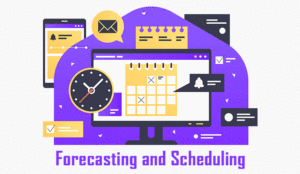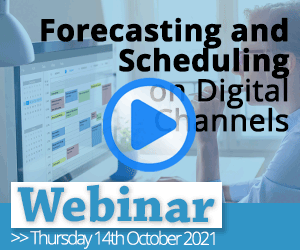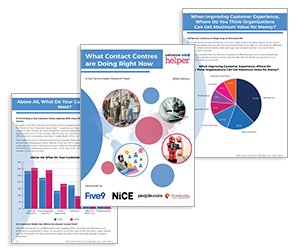Forecasting and scheduling for digital channels isn’t a one-size-fits-all exercise. It requires a deep understanding of how each channel behaves and what your agents need to succeed.
So, what does best practice look like? We asked the experts to find out…
15 Tips for Forecasting and Scheduling on Digital Channels
1. Track the Whole Journey – Not Just the First Contact
In digital, customers switch channels fast. They might start in chat, jump to email, then call.
Forecasting has to track the whole journey, not just the first contact, and that means using different data sources and smarter models.
2. Be Mindful That Volume Patterns Are Less Predictable in Digital
Call volumes and digital traffic behave very differently, and you need to be mindful of this.
Call volumes typically follow set patterns (lunch dips, Monday peaks, etc.). However, digital traffic can spike suddenly due to things like a tweet going viral or a system issue being shared online.
Contributed by: Phil Anderson, CEO at The Forum
3. Don’t Bundle Your Digital Channels Together – They All Behave Differently!

Do you know how each channel behaves?
- Take chat, for example: getting concurrency right is critical, but it’s not just about maximizing volume. You need to account for task complexity, agent skill, and customer expectations to avoid burnout and poor experiences.
- For email, the patience window might be longer, but volume forecasting and handle time can be tricky – especially when messages get routed between teams. Here, the right data and tools are essential to maintain service levels without overstaffing.
- Social media adds another layer: interactions are often witty, highly personalized, and public. That makes agent coaching and tone calibration more important than ever.
Each channel brings its own rhythm, and your WFM strategy needs to match it – accurately, flexibly, and always with the customer in mind.
Contributed by: Florian Garnier, Product Marketing Manager, Calabrio
4. Get to Grips With How Channels Introduce Different Staffing Pressures

Any forecasting is only as good as its inputs. That means that, if scheduling isn’t running smoothly, you need to go right back to the data that’s informing it.
When customers expect the same level of experience across many different channels, that adds enormous complexity to forecasting: not just juggling where contacts are coming from but understanding how those channels introduce different staffing pressures.
For example, customers tend to opt for asynchronous interactions across digital channels like email or WhatsApp.
These exchanges can span multiple intervals and need to be supported 24/7 as when in the day they tend to start might not accurately indicate when you need the most staff to handle them. More advanced forecasting methods are available, though.
Dutch Railways recently adopted a True-to-Interval (TTI) approach which accurately records when a contact was answered and actively being worked on. This empowered them to analyse and fix patterns of over- and understaffing.
Contributed by: Andrea Matsuda, Head of Product Marketing, WFM, NICE
5. Cross-Train Your Agents to Move Between Channels and Help Balance Service Levels – Without Overstaffing

Forecasting and scheduling for digital channels requires a data-led, flexible approach.
Build schedules with buffer capacity and consider concurrency when assigning workloads – agents can typically handle multiple digital conversations at once.
Cross-training is key; having agents who can move between channels helps balance service levels without overstaffing.
Define channel-specific SLAs and make sure they’re clearly communicated to the team. And don’t forget agent wellbeing – digital work can be mentally taxing, so factor in adequate breaks and rotations. The goal is to meet demand efficiently without burning out your people.
Contributed by: Tara Aldridge, Strategic Services Director, Vonage
If you aren’t sure if multiskilling your agents is the best decision for your contact centre, read our article: Multi-Skilling Agents – Is It Really Best?
6. Consolidate Forecasts Across All Customer Touchpoints to Avoid Blind Spots

In today’s hybrid world, digital channels don’t operate in silos – nor should your planning.
Omnichannel WFM solutions consolidate forecasts across all customer touchpoints, from voice to social media. This unified view helps planners understand the real workload and optimize staffing without double-counting or leaving blind spots.
It also makes it easier to reassign agents flexibly across channels in real time, boosting both efficiency and responsiveness.
With centralized forecasting and smart scheduling, contact centres can maintain consistent service quality while minimizing idle time and making the most of every available resource.
Contributed by: Isabel Lim, Marketing Manager, Peopleware
Watch the video below to hear Adlai Salcedo, Marketing Manager at peopleware, explain how contact centres can improve their forecasting and scheduling by staying ahead when customers are using digital channels.
7. Implement Feedback Loops for Discussing Trends With the Wider Organization

Real-time visibility helps you stay agile in your operations. However, it’s also important to implement feedback loops for discussing trends with the wider organization.
This collaborative approach helps refine processes and customer journeys, improve take-up rates and reduce volatility.
If your digital offerings fail to meet expectations due to technological issues or workforce planning, customers will likely revert to traditional voice channels, which can be costly for your business.
Contributed by: Lewis Gallagher, Senior Solutions Consultant, Netcall
8. Separate Contacts Into Two Classifications – First Contacts and Subsequent Interactions
Break down your digital channel forecasting.
Start by separating contacts into two classifications: first contacts requiring quick response and subsequent interactions within the same conversation.
Each contact reason has different patterns, so mapping these prevents getting lost in averages when forecasting for them.
9. Consider How You Incorporate Conversation Timeouts Into Your Forecasting

Handle-time components for asynchronous channels include writing to customers, researching answers, and wrap-up time.
The real challenge comes in defining conversation timeouts… If a customer hasn’t responded in minutes, should the conversation be timed out for efficient capacity management?
Make sure you consider how you incorporate that into your forecasting modelling.
10. Set Appropriate Service Level Targets to Meet Customers’ Expectations – Especially for Messaging
Messaging’s asynchronous nature means service peaks can be spread out, potentially decreasing staffing requirements.
However, unlike email, customers expect faster responses, making regular checkpoints essential, so ensure you set an appropriate service level target to meet this expectation.
Contributed by: Doug Casterton, Workforce Optimization Consultant at Right Time Right Place
11. Avoid Using the Same Forecasting Method as Inbound Voice Channels

For forecasting, it is crucial to thoroughly understand historical volume data. Study the data tables carefully and make sure the items you are using for reporting align with your expectations. It may also be necessary to clean the data to remove events such as system downtime.
Analyse the historical variation to identify the key factors that are causing the digital volume to change – within day, from day to day, and week to week.
This insight will help you select the most appropriate forecasting model. Avoid using the same method simply just because it has worked well for inbound voice channels; digital channels often require a different approach.
Contributed by: Philip Stubbs, Partner at Atlantic Insight
12. Adapt Your Forecasts in Line With How Customers Engage With Each Channel
It’s essential to recognize that digital channels are not all the same. Customers engage with each channel based on various factors such as urgency, complexity, timing and tolerance.
This variability affects your forecasts, staffing levels and service level agreements (SLAs). For instance, demand services like webchat require nearly instant responses, while other asynchronous channels, such as WhatsApp, social media or email, can accommodate slight delays.
Contributed by: Lewis Gallagher, Senior Solutions Consultant, Netcall
13. Don’t Underestimate the Different Agent Skill Sets Required
Phone agents need great verbal skills. Digital agents need to write quickly and clearly, often across multiple chats or platforms.
So scheduling isn’t just about coverage – it’s about getting the right skills at the right time.
14. Stretch Your Scheduling Further – With More Part-Time, Evening, or Flexible Shift Options to Match Demand

Digital channels are often 24/7 or at least extended hours. That means scheduling has to stretch further, with more part-time, evening, or flexible shift options to match demand across time zones or peak usage hours.
Compared to traditional call scheduling, which often works in big chunks (e.g. 8am–4pm), digital can work in shorter bursts – even hour-by-hour – because of volume variability and concurrency.
This means more dynamic schedules and potentially more frequent reforecasting or intraday adjustments.
Contributed by: Phil Anderson, CEO at The Forum
15. Build in Breaks and Buffer Time to Avoid Burnout
Make sure your WFM system supports skill-based routing, so the right conversations go to the right people.
Cross-train your agents to handle multiple digital channels confidently, increasing flexibility and coverage. And don’t forget to build in breaks and buffer time to avoid burnout!
When multiskilled teams are scheduled thoughtfully, you’ll see faster responses, smoother handovers, and more resilient, engaged service teams.
Contributed by: Isabel Lim, Marketing Manager, Peopleware
For first-hand advice on how best to manage agent breaks in the contact centre, read our article: Is It Best to Schedule or Free-Style Agent Breaks?
How Do You Overcome the Challenges of Forecasting and Scheduling in Digital Channels?
Join our LinkedIn community and let us know.
For more great insights and advice from our panel of experts, read these articles next:
- Top Tactics to Improve First Contact Resolution (FCR)
- Are Chatbots the Tech We All Love to Hate?
- 10 Game-Changing Ways Emotion Will Shape the Future of CX
- New Ways to Empower Agents in 2025
Author: Megan Jones
Reviewed by: Jo Robinson
Published On: 19th May 2025 - Last modified: 13th Aug 2025
Read more about - Workforce Planning, Andrea Matsuda, Calabrio, Doug Casterton, Editor's Picks, Florian Garnier, Forecasting, Isabel Lim, Lewis Gallagher, Netcall, NiCE, NiCE CXone, Omnichannel, Peopleware, Phil Anderson, Philip Stubbs, Scheduling, Shift Patterns, Staffing, Tara Aldridge, The Forum, Top Story, Vonage, Workforce Management (WFM), Workforce Planning


















